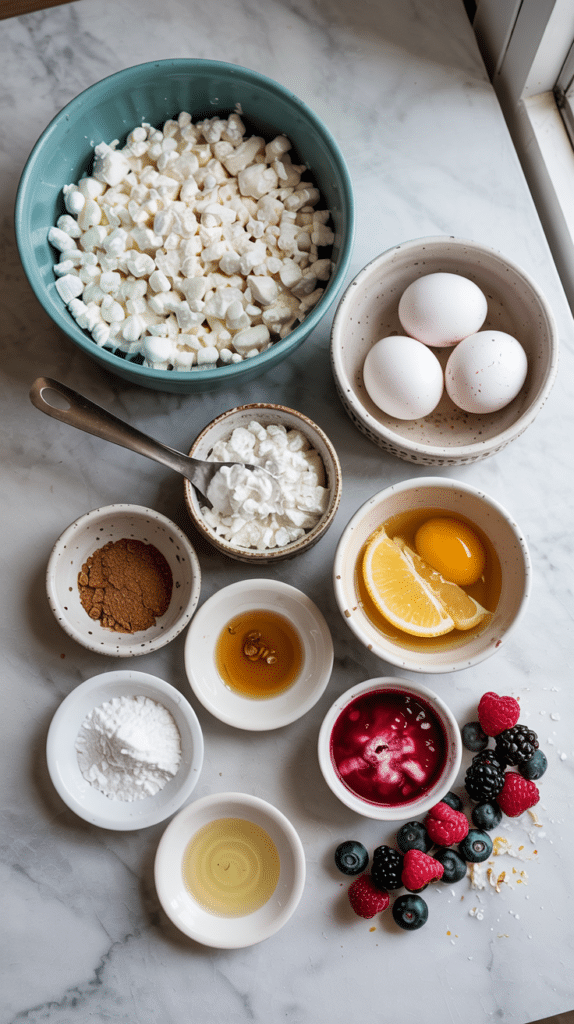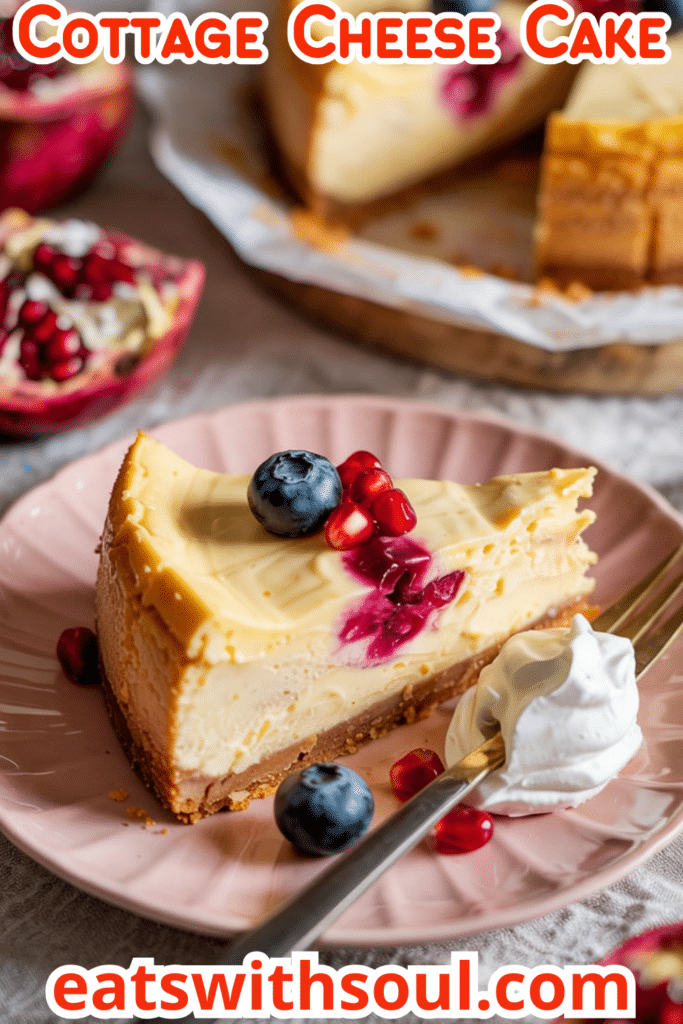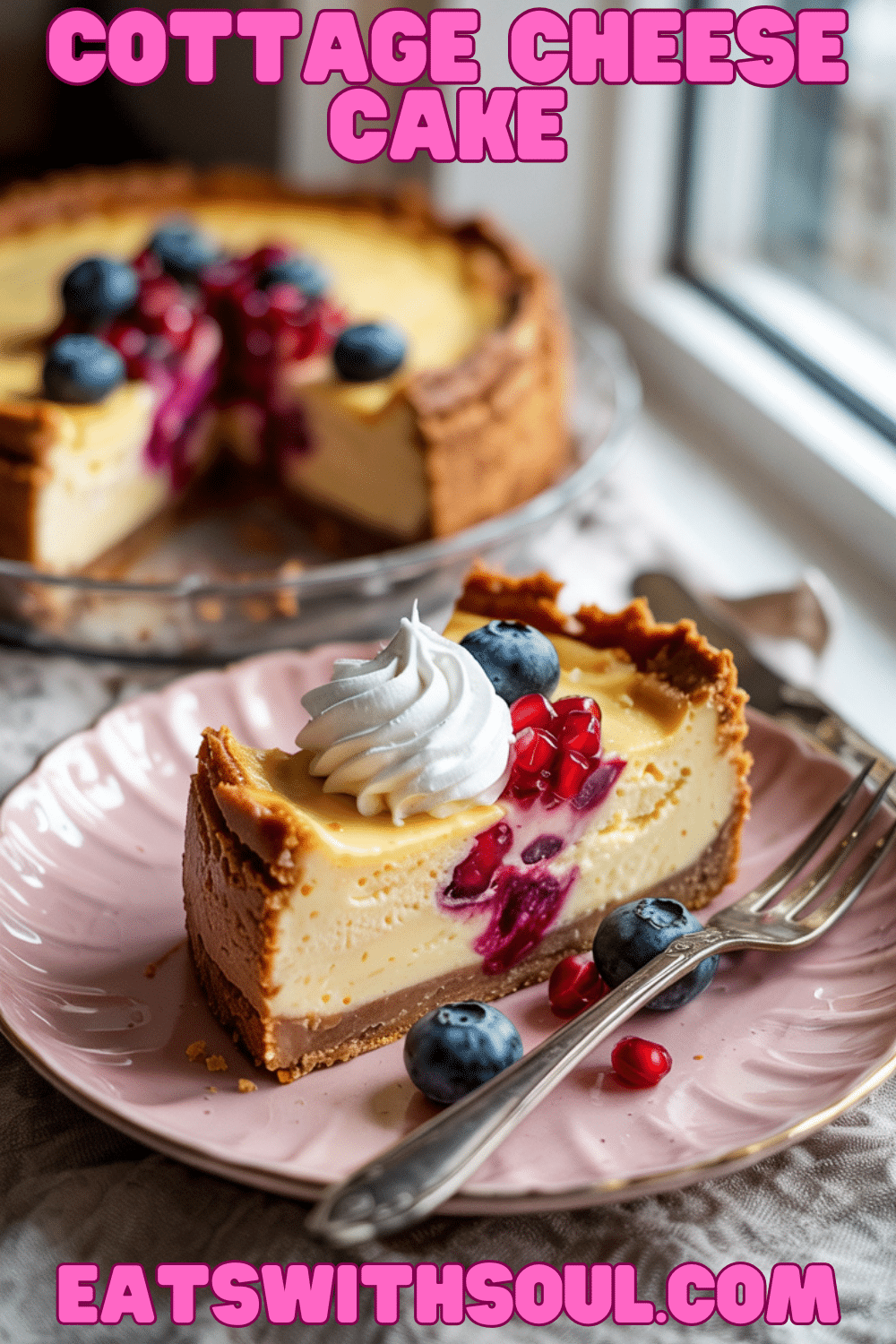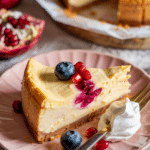Introduction & Inspiration
Discover the delightful surprise that is Baked Cottage Cheese Cake! If you’re looking for a dessert that’s reminiscent of cheesecake but lighter, simpler, and packed with protein, this recipe is a must-try. We blend full-fat cottage cheese until perfectly smooth with eggs, your choice of sweetener, vanilla, almond, and lemon juice, then simply bake it in a pie plate until set. The result is a creamy, custard-like cake with a beautiful golden top.
My inspiration for this comes from exploring healthier, protein-rich dessert alternatives and loving the versatility of cottage cheese. Baking the blended mixture transforms it into something entirely different – a smooth, satisfying, crustless cake that’s incredibly easy to whip up.
This Cottage Cheese Cake is perfect when you want a simple yet elegant dessert, a lighter alternative to traditional cheesecake, or a unique way to boost your protein intake. It’s wonderful served chilled with a fresh berry coulis. It is a perfect healthy dessert.
Nostalgic Appeal / Comfort Factor
While “Cottage Cheese Cake” might not sound like a traditional nostalgic dessert, its final taste and texture tap into the comforting appeal of classic cheesecakes, baked custards, and simple European-style cheese tarts. The creamy texture and tangy-sweet flavor profile feel familiar and satisfying.
The subtle vanilla and almond notes add a classic dessert aroma. It’s a simple, unpretentious bake that delivers pure comfort in a slightly lighter, protein-forward way compared to heavy cheesecakes.
It feels like a wholesome, comforting treat, perfect for a quiet dessert or a simple gathering. A perfect recipe to try something different.
Homemade Focus (Simplicity, Blending & Baking)
This recipe is a fantastic example of simple homemade baking where technique transforms basic ingredients. The core “homemade” aspect lies in blending the cottage cheese until completely smooth – the key to achieving the desired cheesecake-like texture – and then baking it gently until set.
You control the ingredients, choosing your preferred sweetener (sugar, erythritol, or stevia are suggested) and ensuring the freshness of the eggs and extracts. The process is incredibly straightforward, relying mainly on the blender and the oven.
It celebrates how easily you can create a unique and delicious baked dessert from scratch with minimal fuss, perfect even for beginner bakers. The homemade taste is incredible.
Flavor Goal
The primary flavor goal is a creamy, slightly tangy, and gently sweet baked custard/cake, subtly flavored with vanilla, almond, and lemon. The cottage cheese provides the primary body and tang, which mellows somewhat during baking.
The chosen sweetener dictates the sweetness level. The extracts provide classic dessert aromas, while the lemon juice adds a necessary touch of brightness to balance the richness of the cottage cheese and eggs. The texture should be smooth, dense yet lighter than traditional cheesecake, firm enough to slice when fully chilled, with puffed edges and a slightly jiggly center when just out of the oven.
The overall experience should be a simple, satisfying, creamy dessert with a pleasant tang and subtle sweetness, perfect as a base for fruit toppings. A perfect balance between flavour and texture.
Ingredient Insights
- Full-Fat Cottage Cheese: The star ingredient! Provides protein, creaminess, and structure. Using full-fat is recommended for the best texture and richness. Blending it completely smooth is essential.
- Large Eggs: Provide structure, richness, and help the cake set during baking. Room temperature preferred.
- Granulated Sweetener (Erythritol, Sugar, or Stevia Glycerite): Offers flexibility. Use granulated sugar for a classic taste, erythritol for a sugar-free option that behaves similarly to sugar, or concentrated stevia glycerite (adjust amount carefully!) for another sugar-free choice.
- Almond Extract & Vanilla Extract: Add classic flavor notes. Almond complements dairy/cheese flavors well.
- Cornstarch: Acts as a binder and thickener, helping the cake set with a smooth texture and preventing weeping.
- Lemon Juice: Adds brightness and cuts through the richness of the cottage cheese and eggs. Freshly squeezed is best.
- Salt: Balances sweetness and enhances overall flavor.
- Serving Suggestion (Berry Coulis): A simple sauce made from pureed berries (like strawberries or raspberries, often with a little sugar/lemon juice) provides a perfect fruity counterpoint.
Essential Equipment
- Blender or Food Processor: Absolutely essential for getting the cottage cheese completely smooth. A tamper attachment (if using a blender like Vitamix) is helpful.
- 9-Inch Pie Plate: The baking vessel. Ceramic or glass is suitable. Ensure it’s greased well.
- Mixing Bowl: For whisking in the eggs after blending the base.
- Hand Whisk (or Stand Mixer Whisk Attachment): For gently incorporating the eggs without overmixing.
- Rubber Spatula: For scraping the blender/bowl.
- Measuring Cups & Spoons:
Ingredients
(Based on 1x column)
Cottage Cheese Cake:
- ▢ 3 ½ cups Cottage Cheese (full-fat recommended)
- ▢ 4 large Eggs
- ▢ ⅔ cup Granulated Sweetener (choose one: erythritol OR sugar OR approx. 1 teaspoon stevia glycerite – adjust stevia to taste/brand potency)
- ▢ ½ teaspoon Almond Extract
- ▢ 2 teaspoons Vanilla Extract
- ▢ 1 tablespoon Cornstarch
- ▢ 1 tablespoon Lemon Juice (freshly squeezed)
- ▢ ¼ teaspoon Salt
Serving Suggestion:
- ▢ ⅓ cup Berry Coulis (homemade or store-bought)
- ▢ Extra fresh berries

Step-by-Step Instructions
1. Prepare Oven and Pie Plate:
- Preheat the oven to 350°F (180°C).
- Grease a 9-inch pie plate thoroughly with butter or coconut oil. Set aside.
2. Blend the Cottage Cheese Base:
- In the container of your blender or food processor, add the cottage cheese, vanilla extract, lemon juice, salt, almond extract, cornstarch, and your chosen sweetener (sugar, erythritol, or stevia).
- Secure the lid. Blend on medium-high speed until the mixture is completely smooth and creamy. If using a blender with a tamper tool, use it to push the mixture down towards the blades. This critical step might take 30-45 seconds or longer depending on your appliance. Stop and scrape down the sides as needed. Ensure absolutely no curds remain.
3. Whisk in Eggs:
- Transfer the smooth blended cottage cheese mixture into a separate mixing bowl.
- Using a hand whisk (or the whisk attachment on a stand mixer on low speed), whisk in the eggs one at a time. Mix just until each egg is combined into the batter. Do not over-whisk at this stage, as incorporating too much air can affect the final texture.
4. Pour into Pie Plate:
- Pour the final mixture into the prepared greased pie plate. Smooth the top gently if needed.
5. Bake:
- Place the pie plate on the center rack of the preheated oven.
- Bake for 45 minutes, or until a toothpick inserted near the edge (about 1 inch or 2 cm from the side) comes out clean.
- The top of the cake should be nicely browned, and the sides should look puffed up. The very center might still have a slight jiggle when gently nudged – this is okay, it will continue to set as it cools.
6. Cool and Chill Completely:
- Let the cake cool completely in the pie plate on a wire rack at room temperature for about 1 hour. It is not meant to be unmolded.
- Once at room temperature, cover the pie plate loosely with plastic wrap (this helps prevent the top from drying out or cracking further).
- Refrigerate overnight, or for at least 3 hours, until thoroughly chilled and fully set. Chilling is essential for the best texture and easy slicing.
7. Serve:
- The next day (or after sufficient chilling), slice the cold Cottage Cheese Cake directly from the pie plate.
- Serve slices with a drizzle of berry coulis and/or extra fresh berries.
8. Store Leftovers:
- Store leftover cake covered in the refrigerator for up to 3-4 days. The recipe notes that some liquid might release at the bottom; placing leftovers on absorbent paper inside the container can help manage this.

Troubleshooting
- Cake Grainy/Not Smooth: Cottage cheese wasn’t blended long enough or blender wasn’t powerful enough. Blend until perfectly smooth before adding eggs.
- Cake Weeping (Watery Bottom): Common with baked custard/cheesecake-like desserts, especially those high in protein/dairy. Can be due to slight overbaking, temperature fluctuations, or just the nature of cottage cheese. The absorbent paper trick for leftovers helps. Ensure it cools completely before chilling.
- Cake Cracked: Often caused by overbaking, cooling too quickly, or overmixing after adding eggs. The gradual cooling and chilling process helps minimize cracking. Cracks are usually cosmetic for this type of cake served in the dish.
- Cake Undercooked/Too Jiggly: Needs more baking time. Ensure toothpick near edge comes out clean. Center will set fully upon chilling.
- Texture Too Rubbery: Likely overmixed after adding eggs, incorporating too much air that then collapses, or possibly slightly overbaked. Whisk eggs in gently and just until combined.
Tips and Variations
- Blend Thoroughly: The absolute key to a smooth, cheesecake-like texture.
- Full-Fat Cottage Cheese: Recommended for the best creamy texture and flavor.
- Cooling/Chilling: Don’t rush the cooling and chilling process; it’s crucial for the cake to set properly and develop the best texture.
- Sweetener Choice: Adjust sweetness based on your preference and the type of sweetener used (especially concentrated stevia).
- Citrus Zest: Add 1-2 teaspoons of lemon or orange zest during the blending step for more citrus flavor.
- Different Extracts: Use all vanilla or add a hint of coconut extract instead of almond.
- Fruit Puree: Blend in 1/4 cup of pumpkin or berry puree (adjust liquid/sweetener slightly if needed).
- Crust Option: If you miss a crust, press a simple graham cracker or cookie crumb crust into the bottom of the pie plate before adding the filling.
Serving and Pairing Suggestions
- Serve Chilled: Essential for the proper set texture.
- With Berry Coulis: The recommended pairing – the tartness cuts the richness beautifully. Raspberry, strawberry, or mixed berry coulis works well.
- With Fresh Fruit: Simply top with fresh berries, sliced peaches, or mango.
- With Whipped Cream: A dollop of lightly sweetened whipped cream is always nice.
- Light Dessert or High-Protein Snack: Versatile enough for either role.
Nutritional Information
(Note: Estimated, per serving, assuming 8 slices. Highly variable based on cottage cheese fat % and sweetener choice – calculation uses sugar equivalent.)
- Calories: 200-300 (Lower if using non-caloric sweetener)
- Fat: 10-18g
- Saturated Fat: 5-10g
- Cholesterol: 100-130mg+
- Sodium: 400-550mg+ (Cottage cheese is high in sodium)
- Total Carbohydrates: 8-25g+ (Highly dependent on sweetener)
- Dietary Fiber: <1g
- Sugars: 5-20g+ (Highly dependent on sweetener)
- Protein: 18-25g+ (Excellent source!)
Simple Baked Cottage Cheese Cake (Crustless & High-Protein)
Bake this easy, high-protein Cottage Cheese Cake! A simple blender recipe creates a smooth, crustless cheesecake-style dessert that’s light, tangy, and delicious.
Ingredients
(Based on 1x column)
Cottage Cheese Cake:
- ▢ 3 ½ cups Cottage Cheese (full-fat recommended)
- ▢ 4 large Eggs
- ▢ ⅔ cup Granulated Sweetener (choose one: erythritol OR sugar OR approx. 1 teaspoon stevia glycerite – adjust stevia to taste/brand potency)
- ▢ ½ teaspoon Almond Extract
- ▢ 2 teaspoons Vanilla Extract
- ▢ 1 tablespoon Cornstarch
- ▢ 1 tablespoon Lemon Juice (freshly squeezed)
- ▢ ¼ teaspoon Salt
Serving Suggestion:
- ▢ ⅓ cup Berry Coulis (homemade or store-bought)
- ▢ Extra fresh berries
Instructions
1. Prepare Oven and Pie Plate:
- Preheat the oven to 350°F (180°C).
- Grease a 9-inch pie plate thoroughly with butter or coconut oil. Set aside.
2. Blend the Cottage Cheese Base:
- In the container of your blender or food processor, add the cottage cheese, vanilla extract, lemon juice, salt, almond extract, cornstarch, and your chosen sweetener (sugar, erythritol, or stevia).
- Secure the lid. Blend on medium-high speed until the mixture is completely smooth and creamy. If using a blender with a tamper tool, use it to push the mixture down towards the blades. This critical step might take 30-45 seconds or longer depending on your appliance. Stop and scrape down the sides as needed. Ensure absolutely no curds remain.
3. Whisk in Eggs:
- Transfer the smooth blended cottage cheese mixture into a separate mixing bowl.
- Using a hand whisk (or the whisk attachment on a stand mixer on low speed), whisk in the eggs one at a time. Mix just until each egg is combined into the batter. Do not over-whisk at this stage, as incorporating too much air can affect the final texture.
4. Pour into Pie Plate:
- Pour the final mixture into the prepared greased pie plate. Smooth the top gently if needed.
5. Bake:
- Place the pie plate on the center rack of the preheated oven.
- Bake for 45 minutes, or until a toothpick inserted near the edge (about 1 inch or 2 cm from the side) comes out clean.
- The top of the cake should be nicely browned, and the sides should look puffed up. The very center might still have a slight jiggle when gently nudged – this is okay, it will continue to set as it cools.
6. Cool and Chill Completely:
- Let the cake cool completely in the pie plate on a wire rack at room temperature for about 1 hour. It is not meant to be unmolded.
- Once at room temperature, cover the pie plate loosely with plastic wrap (this helps prevent the top from drying out or cracking further).
- Refrigerate overnight, or for at least 3 hours, until thoroughly chilled and fully set. Chilling is essential for the best texture and easy slicing.
7. Serve:
- The next day (or after sufficient chilling), slice the cold Cottage Cheese Cake directly from the pie plate.
- Serve slices with a drizzle of berry coulis and/or extra fresh berries.
8. Store Leftovers:
- Store leftover cake covered in the refrigerator for up to 3-4 days. The recipe notes that some liquid might release at the bottom; placing leftovers on absorbent paper inside the container can help manage this.
Recipe Summary and Q&A
Summary: This Baked Cottage Cheese Cake is a crustless, high-protein dessert made by blending full-fat cottage cheese with eggs, a chosen sweetener, extracts, cornstarch, and lemon juice until completely smooth. The mixture is poured into a greased pie plate, baked until set, then cooled completely and chilled thoroughly before serving, typically with a berry coulis.
Q&A:
- Q: Does this taste exactly like cheesecake?
- A: It has a similar creamy, tangy, baked custard-like profile, but the texture is often slightly lighter and less dense than a very rich, traditional New York cheesecake. It’s a fantastic, easier, higher-protein alternative. The flavor is primarily driven by the cottage cheese tang, sweetener, and extracts.
- Q: Why does the recipe say to whisk in the eggs separately after blending?
- A: Blending incorporates a lot of air. While great for smoothing the cottage cheese, incorporating too much air after adding the eggs (which provide structure) can sometimes lead to excessive rising followed by collapsing or cracking during baking. Gently whisking them in provides better control over the final texture, aiming for density rather than extreme airiness.
- Q: Can I use low-fat cottage cheese?
- A: Yes, but full-fat (4% or higher) is recommended for the creamiest texture and richest flavor, more closely mimicking cheesecake. Low-fat versions might yield a slightly less rich or potentially more watery result.
- Q: My cake released water after chilling. Is that normal?
- A: A small amount of liquid weeping is relatively common for baked cottage cheese or custard desserts due to the high protein/moisture content. The recipe note about using absorbent paper for leftovers acknowledges this possibility. Ensuring the cake cools fully before chilling and not overbaking can help minimize it.

